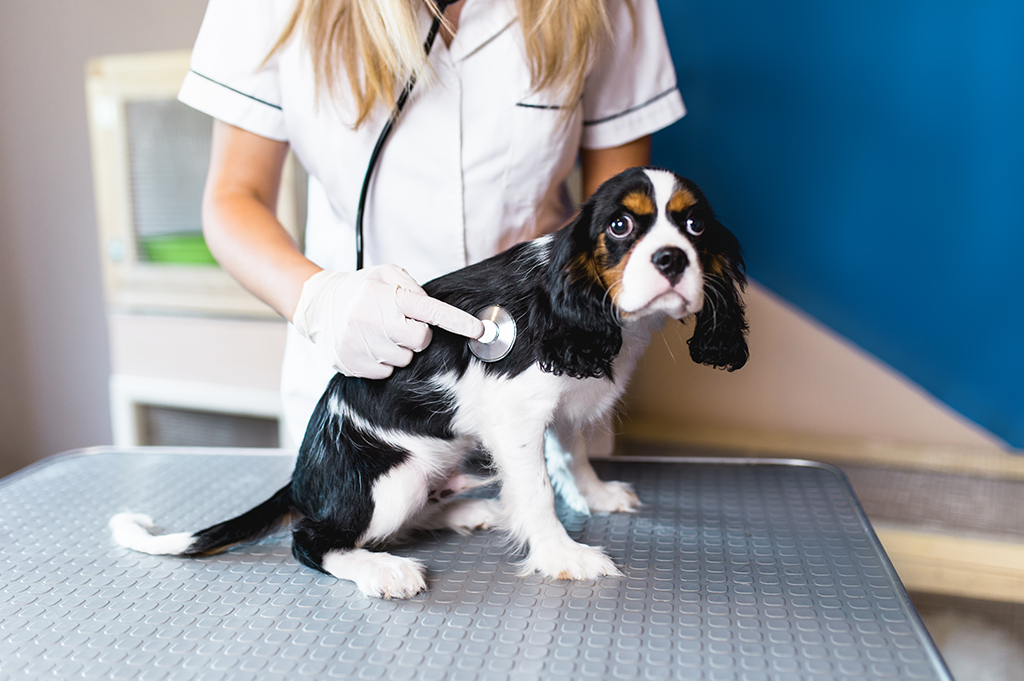As dog owners, it’s never easy seeing our pets in pain. Unfortunately, syringomyelia is a common condition in certain breeds of dogs, particularly Cavalier King Charles Spaniels. Syringomyelia in dogs is a progressive condition which can cause symptoms from sensitivity and pain to paralysis and seizures. At The Insurance Emporium, we’ve put together our guide to syringomyelia and how best to manage the condition for your pet.
What is syringomyelia?

Syringomyelia is caused by an altered flow of cerebrospinal fluid (CSF), leading to pockets of this fluid building up in the spinal cord. These cavities of CSF, known as syrinxes, can cause extreme pain in your dog’s shoulders, neck, head and chest. Most commonly seen in Cavalier King Charles Spaniels, some dogs may exhibit little to no symptoms, while others can experience severe pain with the condition.
What causes syringomyelia?
The most common underlying cause of syringomyelia in dogs is known as a chiari-like foundation (CLF), sometimes known as a chiari malformation. CLM is used to describe when your dog’s brain is too large for its skull, causing an obstruction to the flow of cerebrospinal fluid found around the brain and spinal cord. While the condition is not necessarily specific to Cavalier King Charles Spaniels, it is suspected to be an inherited condition in the breed.
What are the common signs of syringomyelia?

As we mentioned earlier in this article, some dogs may show no signs or symptoms if they have syringomyelia, and the condition can be relatively painless. If your dog is suffering though, one common sign is known as phantom scratching. Your dog may scratch close to one shoulder or one side of their neck without making contact. They may also experience pain, and yelp when handled or if you touch the affected areas.
Your dog also might not want to jump or climb due to the pain. You might also notice some balance issues, facial nerve paralysis and even deafness.
How is syringomyelia diagnosed?

The most common and most effective diagnosis method for syringomyelia is an MRI, a scan which can produce detailed images of the inside of the body. X-rays are generally not very useful for diagnosing CLM, so an MRI is necessary. This is usually a safe procedure, but since it needs to be performed under a general anaesthetic there is always some risk inherited with the diagnosis. You might also want to screen a Cavalier King Charles Spaniel for syringomyelia if you plan to breed them. It’s vital not to breed a dog with syringomyelia even if they aren’t showing symptoms, as the condition is believed to be hereditary.
Since it is believed to be hereditary, it may be possible to diagnose syringomyelia with a genetic test in the future.
What breeds are most commonly affected by syringomyelia?

By far the most common breed of dog affected by syringomyelia is the Cavalier King Charles Spaniel. In fact, it is believed the condition may be hereditary in the breed, and in the future a genetic test may be able to diagnose a dog without the use of an MRI. Other than Cavaliers, other dog breeds can be prone to syringomyelia include:
– Affenpinscher
– Bichon Frisé
– Boston Terrier
– Brussels Griffon
– Bull Terrier
– Chihuahua
– French Bulldog
– Havanese
– Maltese Terrier
– Miniature Dachshund
– Miniature Poodle
– Toy Poodle
– Papillon
– Pomeranian
– Pug
– Shih Tzu
– Staffordshire Bull Terrier
– Yorkshire Terrier
How is syringomyelia treated?
The main goal for the treatment of syringomyelia is pain relief. It’s an important aspect of treatment, as the pain can prevent your pet from exercising and affect their mental health. Your vet may recommend a pain reliever, as well as a medication to reduce the cerebrospinal fluid formation.
Sub-occipital decompression surgery is also available, which can help to reduce pain and remove neurological deficits. But around half of dogs who undergo this treatment experience symptoms again within two years of the surgery. We’d always recommend consulting with your vet before deciding whether or not surgery is necessary for your dog.
What is the prognosis for dogs with syringomyelia?

Syringomyelia and chioro-like malformation is rarely fatal, but can be extremely painful for your dog, especially if the pain goes unmanaged. Lifelong medication is typically required, and your dog will most likely need increasing doses of medication throughout their lives. In some cases, the pain may get so bad for the dog that euthanasia can be necessary.
However, many owners report that their dogs still have a good quality of life, like one of our policyholders Lisa, whose Cavalier King Charles Spaniel, Lucie, was diagnosed with syringomyelia. You can read more about Lucie the Cavalier King Charles Spaniel’s experience with syringomyelia in our testimonial.
Syringomyelia is a common condition in Cavalier King Charles Spaniels, but with the right management, your dog could still have a good quality of life. If you have a dog, or you’re thinking of introducing a furry friend to your home, you might want to think about taking out insurance for your dog. At The Insurance Emporium, our Pet Insurance can include cover for Vet’s Fees up to £8,000* to help in case of accident or illness. What’s more, selected Pet Insurance products are Defaqto 5 Star Rated^! Head on down to The Insurance Emporium to see if we have the right cover for you!
* Vet’s Fees cover up to £8,000 available on lunar or calendar monthly Lifetime Gold Pet Insurance products.
^ Defaqto 5 Star Rating applies to Lifetime Gold Pet Insurance products, and Lifetime Silver and Maximum Benefit Gold Pet Insurance products where the premiums are paid monthly.
All content provided on this blog is for informational purposes only. We make no representations as to the accuracy or completeness of any information on this site or found by following any link on this site. We will not be liable for any errors or omissions in this information nor for the availability of this information. We will not be liable for any loss, injury or damage arising from the display or use of this information. This policy is subject to change at any time.


